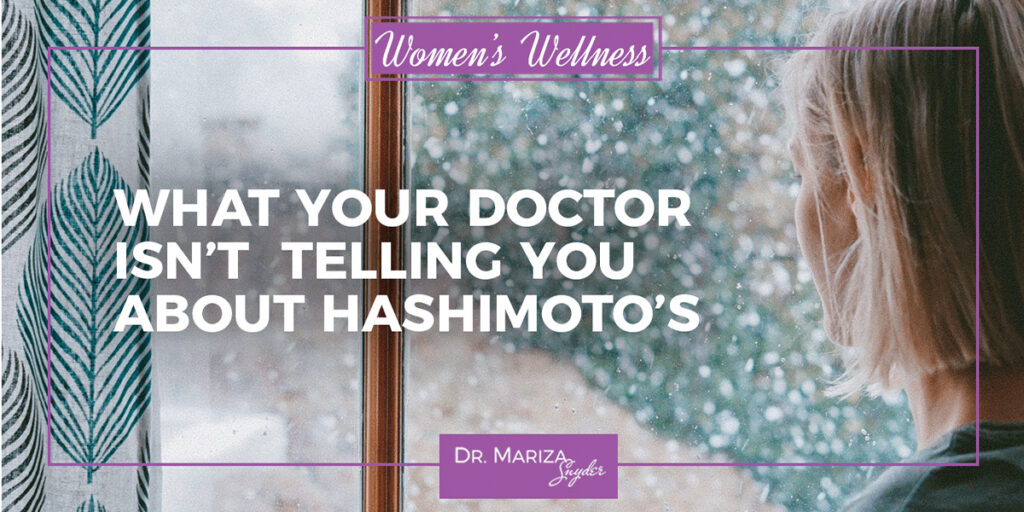
Getting a diagnosis of an autoimmune disease like Hashimoto’s can be devastating and daunting. I know because I have been there and it can feel hopeless at first. But even when conventional medicine says that autoimmune diseases are lifelong, there is hope!
I am living proof that you can be the CEO of your own healthcare!
You can say goodbye to those symptoms and find your way back to wellness for your whole body by becoming a healer in your own home.
There is a safe and natural way to get at the root of the problem and use effective, natural methods to rebalance those hormones and get your body back.
What Is Hashimoto’s?
Hashimoto’s thyroiditis is an autoimmune condition that causes your immune system to target the thyroid as an intruder and attack it with antibodies, causing reduced thyroid function and a host of possible symptoms. It is common for people in early stages of Hashimoto’s to exhibit hyperthyroid symptoms such as excessive sweating, increased heart rate and blood pressure, anxiety, weight loss, and fatigue, just to name a few.
When the antibodies begin to target your thyroid, it pushes the gland into overdrive and your body desperately tries to compensate and keep up. However, as the disease progresses and the thyroid gland continues to be attacked by your body, symptoms of hypothyroidism take over and that is when you notice it. These prevalent symptoms include things like fatigue, sensitivity to cold, dry skin, weight gain, muscle and joint pain, heavier periods, brain fog, hair thinning, and depression.
How Do I Know if I Have Hashimoto’s?
You can’t know what is going on with your thyroid until you have a full thyroid lab panel run, but even then there may be some sleuthing that needs to be done. What is difficult about a Hashimoto’s diagnosis is that it can present in different ways in different people. A clear answer can often be found with elevated levels of thyroid-stimulating hormone (TSH), decreased T4, and the presence of anti-thyroid antibodies (TPO and TGAb).
For others, however, your thyroid hormone levels could appear within a normal range on standard tests like mine did. My thyroid hormone levels appeared to be in great shape, but, under the surface, my immune system was targeting my thyroid. Because I knew to ask for thyroid antibody tests (TPO, TGAb), my healthcare team and I found that my immune system was already targeting my thyroid.
It is vital to get a full thyroid panel if you suspect Hashimoto’s may be what is causing your symptoms. The presence of TPO antibodies is the clearest indication of Hashimoto’s, but it is not included in many general practitioners’ panels.
I recommend seeing a functional practitioner and specifically requesting these tests. Do your research so you can be the CEO of your healthcare and make the necessary decisions and changes!
What Causes Hashimoto’s?
Hashimoto’s can be initiated by several different factors, or, for most people, a combination of them. Here are some possibilities:
- Nutrient deficiency
- Leaky gut syndrome (caused by food intolerance or stress)
- Hidden infections
- Elevated toxic load
- Stress or trauma
Personally, I had to address a number of these factors to find relief from my symptoms. I had to rebuild my gut microbiome, cut out foods that I know were causing some inflammation, start new supplements to help bridge my nutrient gaps and support my cells’ ability to handle stress, and use oils in a daily self-care routine to find mental calm and support my body’s functions, especially loving my liver to help get rid of the toxins in my body.
As you can see, sometimes it takes multiple steps to heal from Hashimoto’s. But taking one step at a time and being conscious of your body’s needs can help you build a plan to get there.
What Are My First Steps?
I know I was wondering where to start to help myself get well after my diagnosis. It can be a long process narrowing down what triggered your autoimmunity. Hang in there, girl! It is worth it to find the root cause and fix that instead of just addressing your symptoms!
While you are working to figure out the root cause of your Hashimoto’s, here are a few things that you can do to help yourself feel better:
- Invest in some self-care. It is amazing how much of an impact de-stressing and taking care of yourself can have.
- Take care of your gut. Your gut microorganisms directly affect your thyroid hormone balance and the progression of Hashimoto’s. Taking a quality probiotic and eating nutrient-dense foods like bone broth, fruits, vegetables, fermented foods, and lean meats can all help restore your digestive tract to health.
- Cut out gluten. There is a link between gluten and the progression of your Hashimoto’s. Removing inflammatory foods, particularly gluten, dairy, and sugar from your diet can also really help you feel better and reduce the amount of antibodies in your system!
- Detoxify. One of my favorite ways to do this is with an Epsom salt bath. Choose oils that will calm your mind and help cleanse your body, combine them with Epsom salts, and enjoy some relaxing self-care that is also promoting your health. Just be sure you hydrate before and after your soak, and limit it to about 20 minutes, rinsing off afterwards, so you don’t reabsorb any of those nasty toxins.
- Support your thyroid with supplements. There are several key nutrients your thyroid relies on to heal, but I’ve combined the heavy-hitters in one place in my Essentially Whole® Thyroid Support. It’s designed to help regulate your body’s stress response and blood sugar levels (two things that greatly impact your thyroid), while also promoting the thyroid gland’s health and your body’s ability to convert thyroid hormones into their active forms. Get it here today!
- Use essential oils. Whether it is to calm my mind, clear my brain fog, or directly affect my thyroid, essential oils are part of my daily self-care routine. Some favorites during this journey with Hashimoto’s have been my Thyroid Support Rollerball blend and my Superwoman blend, which is my go-to for all-around hormone support.
Thyroid Support Rollerball Blend
Ingredients:
6-8 drops Lavender essential oil
5 drops Frankincense essential oil
5 drops Clove essential oil
5 drops Lemongrass essential oil
5 drops Myrrh essential oil
5 drops Peppermint essential oil
Carrier oil of choice
Directions:
Add oils to a 10-ml glass rollerball bottle and top off with a carrier oil of your choice. Replace top, cap, and swirl to combine. To use, apply daily directly to your thyroid.
Superwoman Blend
Ingredients:
12 drops Clary Sage essential oil
10 drops Lavender essential oil
5 drops Cedarwood essential oil
5 drops Geranium essential oil
4 drops Ylang Ylang essential oil
Optional: 4 drops of Jasmine or Rose Touch essential oils
Carrier oil of choice
Directions:
Add oils to a 10 mL glass rollerball bottle and top off with a carrier oil of choice. Replace top, cap, and swirl to combine. To use, apply to wrists, inner arm, lower abdomen, and/or neck as needed, or apply it to your palms and inhale it for an immediate uplifting experience!
Getting Started with Essential Oils? Let me help!



No comments yet.